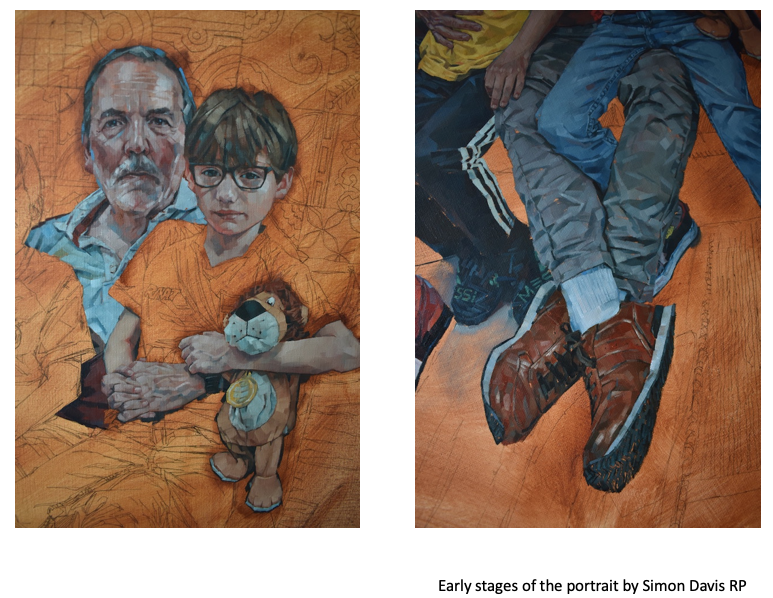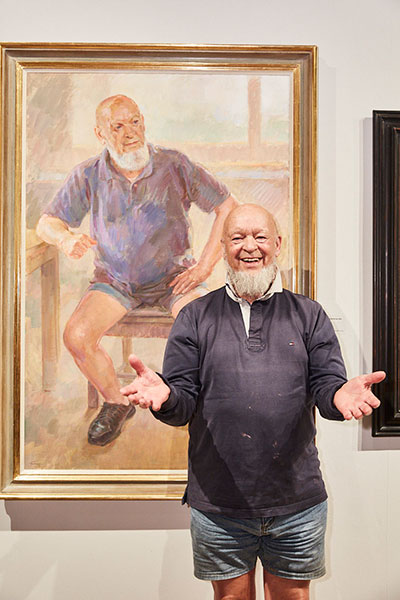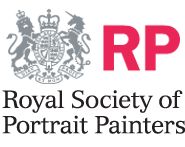In ‘What Portrait Painters Need to Know when Working to Commission’ Annabel Elton, Head of Portrait Commissions at the Federation of British Artists gives hints and tips for artists working on Portrait Commissions.
This series of videos, filmed at Heatherley School of Fine Art, focuses on advice for artists when working on portrait commissions.
This chapter focuses on Communication and Client Expectations.
Other videos in the series include:
- How to Get Yourself Seen: The Four Curated Options
- How to Get Yourself Seen: Marketing & Promotion
- The Client’s Perspective
- Pricing
This video focuses on pricing, and how to build a pricing structure when working to commission.
Your client will see you as the expert
You may not think of yourselves as experts, but nine times out of 10, the person sitting for you or the person commissioning the work, won’t have commissioned a portrait before.
So you are the expert, and it’s your job to make them feel safe. You need to manage their expectations along the way and stay one step ahead all the time so they know what’s happening next.
And that’s not just on a mechanical level. It’s on an emotional level too. I had a problem with a portrait once where there was a failure of communication, and the sitter felt that the artist didn’t want to didn’t want to draw them.
And this wasn’t the case. What was happening really was the artist had their own personal problems, which meant he wasn’t in communication and wasn’t responding to calls – and an email to say, forgive me if I go quiet for a while I’ve got things to deal with, I’ll come back to. It would have stopped all that happening.
So manage expectations when things go wrong, particularly if you need to start again or sitting has to be cancelled, if you’re going to be late, just manage it ahead of time. The client will feel respected and safe.
Contracting
An agreement in writing is really important and that’s what you go back back to to make sure things are clear.
Portraits are a very personal thing. They’re not usually very contractual. I very rarely draw up a full contracts except for American lawyers or British solicitor. I do do a few contracts, but it’s usually for business not for personal commissions.
Much of it is about the relationship and trust. You just draw out the broad parameters of what’s expected:
- Size
- Medium
- Content.
- Timings
All the things that are important to the client. Be organised, punctual and polite. Not turning up on time can show disrespect rather than disorganisation. So it needs to be ameliorated if it goes wrong.
Case Study:
I just thought I’d talk about an actual commission.
This one’s just being finished. It came about through the death of a father. It rather brought David, the commissioner, up short. It made him realise how important families are.
And it made him aware of his own mortality. A portrait is something that’s a weapon against ephemerality against mortality. It throws love into the future. It’s a legacy for future generations.
So he thought that a portrait commission would be a good way to spend his inheritance.

This is an interesting family – a gay couple with two adopted sons. So bonding the family and making them feel part of a legacy was particularly important to this commission motivation.
They wanted a large picture of the family looking relaxed in football kits… sofa. Not a formal setup traditional portrait. So they started by looking online. And they found Simon Davis.
Simon’s practice is to take photographs. Simon went up and saw them and spent a day with them taking photographs as he went observing quietly while he wasn’t photographing. He talked about the composition, the location, and they worked on that together and then he showed them his photographic compositions for approval, and they worked on those until they got one they were all happy with.
He then built the painting up from a drawing, taking on the key pieces. If you note they’re all intertwined, the knees touch the hands touch, the whole family is bound together.
This was done in a matter of months after a delay for various personal reasons. And it’s something that the family treasure. It has bought them a sense of lasting-family and an object that they really enjoy. And I think Simon has caught them looking really relaxed. I love the way that they are intertwined. And the busyness of the background.
It’s amazing how many people are profoundly moved by their portrait, I don’t think you as creators realise how much they mean to the sitter’s.
Very often, somebody will burst into tears on seeing a portrait for the first time.
(I just thought I’d bring this one out. I love this. He’s a great character, and really enjoyed the whole thing we June Mendoza.)
When your client first sees their portrait
But this is to say don’t panic a sitter is a little bit taken aback when they first see their portrait or they see a portrait of somebody they love.
Because we’re used to seeing ourselves in the mirror. That’s the wrong way round. We see ourselves in photography. That’s a snap of a moment.
We have never seen ourselves, having gone through the imagination of an artist. And for a moment, everything that’s different to that can seem not right to the sitter. We’re very Funny about our own images.
I think we all have a little bit of dysmorphia. Sometimes I look in a mirror and I think I look really great. And other times I think I look very sad and decrepit and actually the level of great that I think I am is the level of decrepit, I think I am, I hope not quite true, either of them.

And all these overlays go on to the first view of a portrait. So don’t panic, if they’re not saying yeah, great like this. It can happen that people are getting used to it and learning.
That doesn’t mean it’s not a good idea to listen and engage with the setter. If they think there’s something wrong about this or that. It doesn’t mean you write them off because they do know themselves. They do know the people they love.
But equally, you are the artist, you are the creator. And you were the one that knows that this is a successful portrait. And very often the sitter will learn over a bit of time.
Yes listen, yes, be adaptive when necessary, but don’t feel it necessary because the clients not settled that it’s wrong. It takes time.
Allowing the person to live with their portrait for a bit, and then see themselves differently, and to enjoy it for what it is and not for what they think it might be or should have been, is a good thing.
Having said which, when I started my career 30 something years ago, I thought it would be fraught with difficulties. I thought, it’s so sensitive, it’s so personal, it’s bound to go wrong. People are bound to get very stressed about this.
Actually, I’ve had years and years of very happy outcomes. And I’m quite pushed to think of examples of things that haven’t worked.
Be assured that you can have confidence that portraiture brings happiness, hopefully, it shows love, and is a legacy of an object of beauty, as well as sentiment to cast into the future.
The key to a happy relationship with your client
The secret is:
- Communicating what you can do
- Communicating what you are doing
- Communicating what you’re going to do.
And that’s two ways: both listening and speaking.
I think if you manage your communications carefully, it’s very easy to be a good commissioned artist.
Annabel Elton is Head of Portrait Commissions at the Federation of British Artists.
Discover other posts from this series:

